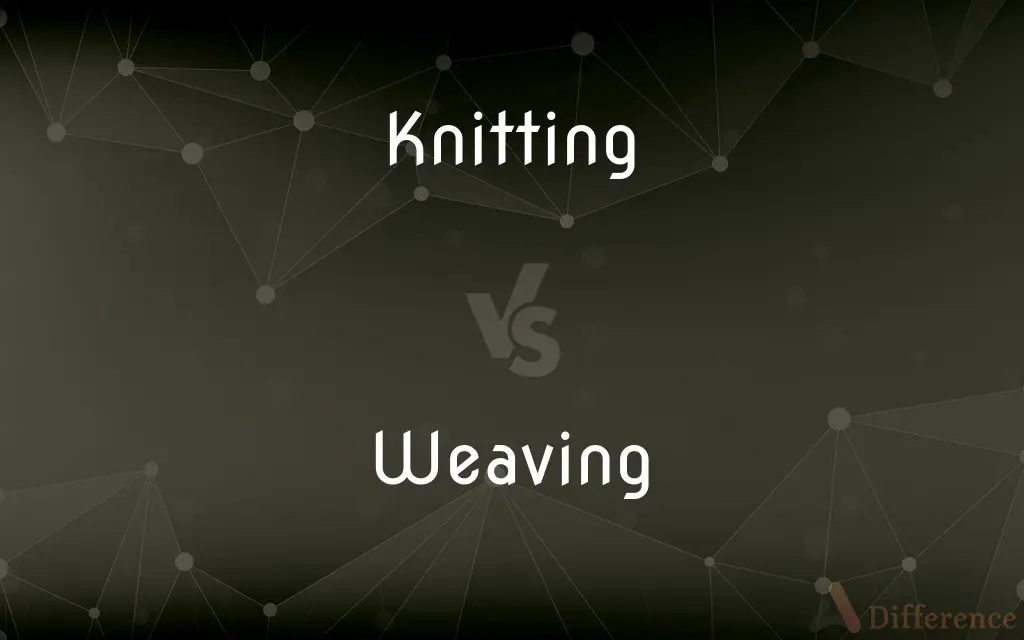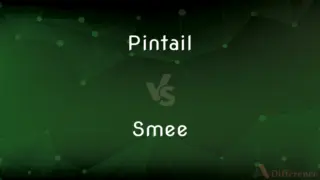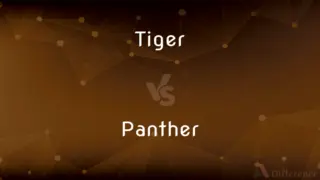Knitting vs. Weaving — What's the Difference?
By Urooj Arif & Fiza Rafique — Updated on March 30, 2024
Knitting involves creating fabric by interlocking loops of yarn with needles, offering elasticity and versatility, whereas weaving intertwines warp and weft threads on a loom for sturdy, less stretchy textiles.

Difference Between Knitting and Weaving
Table of Contents
ADVERTISEMENT
Key Differences
Knitting can be performed either by hand or machine, using a pair of needles to create consecutive rows of loops, known as stitches. This technique allows for a great deal of flexibility and stretch, making it ideal for garments like sweaters and socks. Weaving, on the other hand, is usually done on a loom, which holds longitudinal warp threads in place while transverse weft threads are woven over and under them. This results in fabrics that are typically stronger and less elastic, suitable for items such as towels, denim, and canvas.
The equipment required for knitting is relatively simple and portable, with hand knitting needing only needles and yarn. This makes knitting an accessible hobby for beginners. In contrast, weaving requires a loom, which can range from small, simple frames suitable for hobbyists to large, complex machines used in industrial textile production. This makes weaving potentially less accessible for casual crafters due to the space and financial investment in equipment.
Knitted fabrics are inherently more elastic, which makes them forgiving and adaptable to various body shapes. This elasticity is a result of the looped structure of knitted textiles. Woven fabrics lack this inherent stretch, offering instead a more structured and stable form. This makes them better suited for items requiring shape retention and durability.
The learning curve for knitting can be relatively gentle, with basic stitches and techniques being easy to master. This makes it a popular choice for those new to textile crafts. Weaving, while not necessarily complicated, can have a steeper learning curve due to the setup of the loom and the coordination required to manage multiple threads and patterns.
Knitting and weaving also differ in their aesthetic possibilities. Knitting allows for a wide range of textures and patterns, including intricate designs like cables and lace, through the manipulation of stitches. Weaving offers its own variety of textures and patterns, achieved through the arrangement of warp and weft threads, but the effects are distinct from those found in knitted fabrics.
ADVERTISEMENT
Comparison Chart
Technique
Interlocking loops of yarn with needles
Interlacing warp and weft threads on a loom
Fabric Elasticity
High elasticity
Low to moderate elasticity
Equipment
Needles (hand) or knitting machine
Loom (from simple to complex)
Suitable For
Garments and accessories
Sturdy fabrics like towels, denim
Learning Curve
Generally gentle
Can be steeper due to loom setup
Aesthetic Variety
Wide range of textures and patterns
Distinct textures and patterns through thread arrangement
Compare with Definitions
Knitting
Can be done by hand or with a machine for greater speed.
For larger projects, she prefers using a knitting machine.
Weaving
The process of making fabric by interlacing warp and weft threads on a loom.
Weaving on her loom, she created a beautiful tapestry for the living room.
Knitting
The craft of creating fabric by interlocking loops of yarn with needles.
She took up knitting to make personalized scarves for her family.
Weaving
Offers patterns and textures through different weaving techniques.
She experimented with various weaving techniques to add texture to her textiles.
Knitting
A method used to produce flexible and stretchy textiles.
Knitting is her go-to technique for crafting cozy winter hats.
Weaving
Requires a loom, ranging from simple frames to complex machinery.
She invested in a compact loom for her small weaving projects.
Knitting
Involves techniques like purl and knit stitches to create various patterns.
She mastered knitting intricate patterns for her sweater designs.
Weaving
Produces sturdy, structured fabrics with limited elasticity.
He uses weaving to make durable denim for jeans.
Knitting
Suitable for creating garments, accessories, and decorative items.
He enjoys knitting socks and mittens as gifts.
Weaving
Used for a wide range of products, including clothing, towels, and home décor.
Her weaving skills are showcased in the handmade placemats on her dining table.
Knitting
Knitting is a method by which yarn is manipulated to create a textile or fabric. It is used in many types of garments.
Weaving
Weaving is a method of textile production in which two distinct sets of yarns or threads are interlaced at right angles to form a fabric or cloth. Other methods are knitting, crocheting, felting, and braiding or plaiting.
Knitting
The act or process of producing something knitted.
Weaving
To make (cloth) by interlacing the threads of the weft and the warp on a loom.
Knitting
Material that has been knitted or is being knitted.
Weaving
To interlace (threads, for example) into cloth.
Knitting
Present participle of knit
Weaving
To construct by interlacing or interweaving strips or strands of material
Weave a basket.
Knitting
The action of the verb to knit; the process of producing knitted material.
I find knitting very relaxing.
Weaving
To interweave or combine (elements) into a complex whole
Wove the incidents into a story.
Knitting
Material that has been, or is being knitted.
She put down her knitting and went to answer the phone.
Weaving
To contrive (something complex or elaborate) in this way
Weave a tale.
Knitting
Overhead electrification wires, OHLE
Weaving
To introduce (another element) into a complex whole; work in
Wove folk tunes into the symphony.
Knitting
The work of a knitter; the network formed by knitting; knitwork.
Weaving
To attach hair extensions to (hair).
Knitting
Union formed by knitting, as of bones.
Weaving
To spin (a web, for example).
Knitting
Needlework created by interlacing yarn in a series of connected loops using straight eyeless needles or by machine
Weaving
Past tense & past participle often weaved To make (a path or way) by winding in and out or from side to side
Weaved our way through the heavy traffic.
Knitting
Creating knitted wear
Weaving
To engage in weaving; make cloth.
Weaving
To work at a loom.
Weaving
Past tense and past participle often weaved To move in and out or sway from side to side.
Weaving
The pattern, method of weaving, or construction of a fabric
A twill weave.
A loose weave.
Weaving
A hairstyle in which hair extensions are attached to existing strands of hair.
Weaving
(uncountable) The process of making woven material on a loom.
Weaving
(countable) A piece of such material.
Weaving
(countable) An unsteady motion back and forth.
Weaving
Present participle of weave
The motorcycle is weaving in and out of traffic
Weaving
Form of gerund
Weaving
The act of one who, or that which, weaves; the act or art of forming cloth in a loom by the union or intertexture of threads.
Weaving
An incessant motion of a horse's head, neck, and body, from side to side, fancied to resemble the motion of a hand weaver in throwing the shuttle.
Weaving
Creating fabric
Weaving
Walking unsteadily;
A stqaggering gait
Common Curiosities
Can I create patterns in both knitting and weaving?
Yes, both crafts allow for a variety of patterns, though the techniques and results differ.
Which is more suitable for beginners?
Knitting is often considered more accessible and suitable for beginners due to the minimal equipment needed and simpler techniques.
What's the main difference between knitting and weaving?
The main difference is in the technique: knitting uses loops of yarn and needles, offering elasticity, while weaving interlaces warp and weft threads on a loom, resulting in sturdier fabric.
Can knitting and weaving be combined in a single project?
Yes, knitting and weaving can be combined for creative projects, using knitting for elastic parts and weaving for structured sections.
Is knitting or weaving faster?
The speed can vary depending on the skill level and complexity, but generally, machine knitting is faster than weaving.
Do I need a lot of space to start weaving?
It depends on the loom size; table looms are compact, but larger floor looms require more space.
What are the environmental impacts of knitting and weaving?
The impact varies based on the materials and methods used, with a trend towards more sustainable practices in both crafts.
What's the best way to learn knitting or weaving?
Starting with online tutorials or local workshops can be a great way to learn the basics of knitting or weaving.
Can weaving be done by hand without a loom?
Some basic weaving can be done without a traditional loom, using simple tools like a frame or cardboard, but it's limited.
Which is better for making clothing?
Both are used for clothing; knitting is ideal for stretchy, fitted garments, while weaving is better for structured items.
Which craft is more expensive to start?
Weaving generally requires a higher initial investment due to the cost of a loom and setup.
Are there eco-friendly options for knitting and weaving?
Yes, both crafts can be eco-friendly, depending on the materials (such as organic yarn or recycled fibers) used.
Can I weave on a knitting machine?
No, knitting machines and looms serve different purposes and cannot be used interchangeably.
Is one craft more versatile than the other?
Both crafts offer versatility in different ways; knitting for elastic and textured items, and weaving for sturdy, patterned fabrics.
Share Your Discovery

Previous Comparison
Pintail vs. Smee
Next Comparison
Tiger vs. PantherAuthor Spotlight
Written by
Urooj ArifUrooj is a skilled content writer at Ask Difference, known for her exceptional ability to simplify complex topics into engaging and informative content. With a passion for research and a flair for clear, concise writing, she consistently delivers articles that resonate with our diverse audience.
Co-written by
Fiza RafiqueFiza Rafique is a skilled content writer at AskDifference.com, where she meticulously refines and enhances written pieces. Drawing from her vast editorial expertise, Fiza ensures clarity, accuracy, and precision in every article. Passionate about language, she continually seeks to elevate the quality of content for readers worldwide.















































